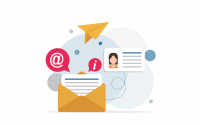11 FAQs about email marketing
Are you thinking about using email marketing as part of your communication mix?
We’ve prepared 11 questions you should pay attention to before incorporating email marketing into your communication strategy:
What do you mean by email marketing software?
This is software for creating, managing and sending emails to a given list of subscribers. Common features include contact management, creating email templates, sending email campaigns, statistics and reporting, and many other functions.
Is email marketing still effective?
Communicating through email marketing is still one of the most effective marketing communication strategies. Despite the popularity of social media and other digital communication channels, email is used by nearly 4.3 billion users worldwide. The average return on investment (ROI) for every 1 USD is 35 USD.
Why is email marketing so important for your brand?
The majority of internet users prefer emails over any other communication channel, up to 70%. Emails act as a great “reminder” of your brand completely free of charge, as email inboxes are very often checked by your consumers.
What are email metrics and what do they even mean?
- Open rate: the percentage of recipients who actually opened the email. A high open rate means that the subject of the email caught the interest of the end users and they opened the message.
- Click-Through Rate (CTR): The percentage of recipients who actually clicked on the link in the email is called the click-through rate (CTR). A high click-through rate indicates that both the calls to action and the content of the email were relevant to the target audience.
- Immediate abandonment rate – bounce rate: emails that failed to deliver and were returned as undeliverable to the sender. A high bounce rate may indicate that the email addresses on the list are invalid or that it has been flagged as spam.
- Conversion Rate: the percentage of customers who complete a desired action, such as completing a purchase or signing up for a service. If an email has a high conversion rate, it has been successful in increasing conversions.
- Unsubscribe Rate: The percentage of customers who have unsubscribed themselves from an email list. When many people unsubscribe from emails, it may be because the communication was irrelevant or the recipient received too many.
- SPAM rate: a measure of how many recipients have marked an email as SPAM. A high SPAM complaint rate means that the content of the email was irrelevant or the recipient was receiving an excessive amount of messages.
Email deliverability and email open rates, what does it mean?
These are two important email marketing metrics that should serve as benchmarks for your marketing success.
Email deliverability refers to the ability of an email to reach the recipient’s inbox. It’s a measure of how many of the emails you send actually make it to the end user’s inbox. Email deliverability can be affected by various factors such as spam filters, email authentication, and email list quality.
The email open rate, on the other hand, is a measure of how many inboxes the recipient actually opens. The calculation is done by dividing the total number of opened emails by the total number of sent emails. A high open rate is an indication of whether the subject line was successful in getting the recipient to open and read the message.
What is the best way to build a successful email strategy?
Creating a successful email strategy involves the following three steps:
- First, decide what your email marketing goals are. Are you using email for customer retention? Or for upselling or cross-selling to convert leads into paying clients? In short, the first step is to identify the quantitative and qualitative elements of those goals.
- Make sure your organization’s overall digital marketing goals are aligned with each component of your corporate strategy.
- And in the last step, create a process for continuous improvement.
How to test and optimize email campaigns?
- Subject line testing: subject line A/B testing is one of the most important steps in optimizing your email campaigns. Try testing different lengths of phrases and calls to action to see which one resonates best with your audience.
- Test different content formats: Try different content formats such as videos, images, banners, etc. to see which generate the highest engagement and click-through rates.
- Monitor the performance of your emails: Use an email analytics tool to measure the performance of your campaigns and see which elements are generating the most clicks and conversions.
- Personalize your messages: Personalize your emails as much as possible and create a more personalized experience for your subscribers. Use segmentation and personalization tactics to send more targeted and relevant content.
- Optimize for mobile: Make sure you optimize your emails for mobile devices so your subscribers can easily view and engage with your content no matter what device they’re using.
- Try different timings: test different timings to determine the best time to send your emails. When optimizing, consider factors such as day of the week, time of day, and frequency of emails
What are the recommended practices to follow in email marketing?
- Use a professional email address: do not use personal email addresses for business communications.
- Use an appropriate subject line: Make sure the subject line is clear and concise so that the recipient can easily understand it.
- Spell and grammar check: Double check spelling and grammar before sending.
- Proper email formatting: Use standard formatting to make your emails easier to read.
- Use your brand tone: Use a consistent brand tone in your communications that corresponds with your target audience.
- Don’t use too many exclamation points: Too many exclamation points can come across as unprofessional.
- Don’t forget the signature: Add a signature at the bottom of the email along with your contact information.
- Use an appropriate salutation: Begin your email by addressing the recipient appropriately (e.g., “Dear Sir/Madam,”).
- Keep your messages concise: Try to keep your emails brief and to the point.
- Use high-quality attachments: Make sure that any attachments you include are of high quality.
- Use a call to action: End your email with a call to action for the recipient to complete.
Can I buy a contact list if I am just starting out with email marketing?
When you’re starting out with email marketing, it’s very easy to get a contact list by purchasing one somewhere. However, we do not recommend this step. A purchased list may contain a large number of outdated email addresses or email addresses of people who have not opted in to receive marketing messages. Sending unsolicited emails can also result in high immediate abandonment rates, low open rates and damage to the sender’s reputation. It’s better to build your own email list by asking your website visitors to sign up through forms on your website or at events if they want to receive your marketing communications. You can only create an email subscriber list that will be useful to your business by allowing it to grow naturally.
What is the difference between soft and hard bounce rate?
A hard bounce rate is an email message that was returned to the sender because the recipient’s address is invalid. This means that the email address does not exist.
A soft bounce rate is an email message that reaches the recipient’s mail server, but before it reaches the end subscriber, it is returned as undelivered. This usually occurs because the recipient’s mailbox is full or temporarily unavailable.
What is the average open rate for newsletters?
The average email marketing open rate varies depending on the industry and the quality of the email list, but is generally between 15-25%. However, some industries can have open rates as high as 50%, while others may struggle to get above 10%. It’s also important to remember that open rates are only one metric for measuring the success of a marketing campaign, and it’s also important to consider factors such as click-through rates and conversion rates.
Conclusion
We hope that today’s article has been inspiring for you and guided you through the basics of email marketing. If you want to incorporate this communication channel into your strategy, use the Reago app where you can easily manage your contact database, create professional looking newsletters and even SMS messages and send them to your contact database.


